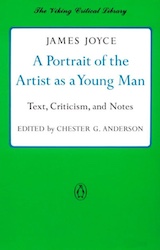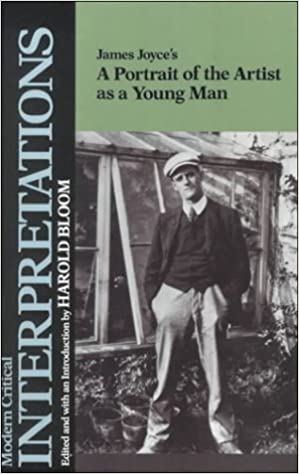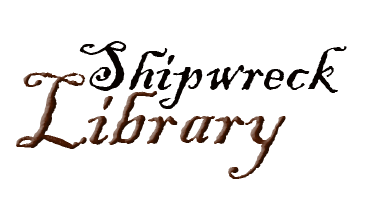Joyce Criticism: “A Portrait of the Artist as a Young Man”
- At November 01, 2021
- By Great Quail
- In Joyce
 0
0
Joyce Criticism: A Portrait of the Artist as a Young Man
This page profiles annotations, guides, and criticism related to A Portrait of the Artist as a Young Man, James Joyce’s semi-autobiographical novel from 1916. Annotated editions of the text are placed first, followed by criticism and guides listed in chronological order of publication. Clicking the image of a book takes you directly to Amazon.com.
Annotated Editions
A Portrait of the Artist as a Young Man: Text, Criticism, and Notes (Viking Critical Library)

A Portrait of the Artist as a Young Man: Text, Criticism, and Notes (Viking Critical Library)
By James Joyce. Edited by Chester G. Anderson.
Viking, 1977
Despite its unforgivable cover, Viking’s critical edition of Portrait serves its subject quite well. The book is divided into four sections. Part I offers the full text of Joyce’s novel. Part II provides “Related Texts by Joyce,” including excerpts from Stephen Hero, the first version of Portrait; as well as fragments from Joyce’s notes, Ulysses, and Finnegans Wake. Part III offers “Criticism,” ranging from early pieces by Ezra Pound and H.G. Wells to established, mid-century Joyceans such as William York Tindall, Richard Ellmann, and Hugh Kenner. Part IV is labeled “Explanatory Notes,” and offers a Chronology, Topics for Discussion and Papers, and a Selected Bibliography.
Criticism & Guides
The Workshop of Daedalus: James Joyce and the Raw Materials for A Portrait of the Artist as a Young Man

The Workshop of Daedalus: James Joyce and the Raw Materials for A Portrait of the Artist as a Young Man
Edited by Robert Scholes and Richard M. Kain
Northwestern University Press, 1965
Available online at: Internet Archive | University of Wisconsin-Madison [PDF]
A critical history of Joyce’s first novel, The Workshop of Daedalus was the first book to publish all 40 of Joyce’s surviving “epiphanies.”
Contents:
Part I: Manuscript Materials
Section 1: The Epiphanies
Section 2: The Paris Notebook
Section 3: The First Version of A Portrait
Section 4: Sparks from a Whetstone
Section 5: The Pola Notebook
Section 6: The Trieste Notebook
Section 7: Fragments from a Late Portrait manuscript
Part II: The Artist as a Young Man
Section 1: Chronology 1882-1904
Section 2: Family
Section 3: Clongowes Wood College, 1888-1891
Section 4: The Fall of Parnell, 1889-1891
Section 5: Belvedere College, 1893-1898
Section 6: University College, Dublin, 1898-1902
Section 7: Sketches of Joyce as a Young Man
Part III: The Esthetic Milieu
Section 1: On Art and Poetry
Section 2: The Poem
Section 3: The Poet
Joyce* Annotated: Notes for Dubliners and A Portrait of the Artist as a Young Man

Joyce* Annotated: Notes for Dubliners and A Portrait of the Artist as a Young Man
By Don Gifford
First Edition: Dutton, 1967
Second Edition, Revised and Enlarged: University of California Press, 1982
Available online at: Internet Archive
In the world of Joyce annotations, Don Gifford has been a reliable guide for decades, and this work belongs on any Joycean’s shelf. Gifford begins with an introduction to Dublin at the turn of the century, including education, history, commerce, and social customs. The book goes on to provide thousands of annotations, including explanations of slang and foreign languages used, relevant song lyrics, literary references, historical notations, and places and institutions mentioned in the text. Maps are sprinkled throughout the book, and it ends with a reprinting of “The Sisters” by “Stephen Daedalus,” as it appeared in the Irish Homestead on August 13, 1904. Overall, a very thorough job that illuminates both works quite nicely!
A Portrait of the Artist as a Young Man (Modern Critical Interpretations)

A Portrait of the Artist as a Young Man (Modern Critical Interpretations)
William Golding, Editor.
Chelsea House, 1988
Available online at: Internet Archive
Part of Harold Bloom’s “Modern Critical Interpretation” series, this book contains eight critical essays, including one by novelist and celebrated Joycean, Anthony Burgess.
From the Publisher: In this volume, which brings together a selection of the best recent criticism of A Portrait, critics investigate Stephen’s relationship to art. Hugh Kenner studies Stephen’s immaturity, while Suzette Henke’s feminist criticism discusses Stephen’s misogyny and its relation to his artist’s prose. Patrick Parrinder contributes and overview of A Portrait which traces the novel’s origins in the work of Wordsworth, Pater, Ibsen, and Wilde.
Contents:
- Harold Bloom: Introduction
- Hugh Kenner, “The Portrait In Perspective”
- Richard Ellmann, “A Portrait of the Artist as a Friend”
- Anthony Burgess, “Martyr and Maze-maker”
- Suzette Henke, “Stephen Dedalus and Women: A Portrait of the Artist as a Young Misogynist”
- Martin Price, “The Beauty of Mortal Conditions: Joyce’s A Portrait of the Artist”
- John Paul Riquelme, “The Preposterous Shape of Portraiture: A Portrait of the Artist as a Young Man”
- Patrick Parrinder, “Joyce’s Portrait and the Proof of the Oracle”
- Michael Seidel, “Monte Christo’s Revenge and Joyce’s A Portrait of the Artist”
A Portrait of the Artist as a Young Man: Voices of the Text

A Portrait of the Artist as a Young Man: Voices of the Text
By Marguerite Harkness
Twain Publishing, 1989
Available online at: Internet Archive
Bob Williams: The Twayne series—often more laudable in intent than result—here justifies itself. It’s a short book, written with vigor and economy. Among the opening chapters is a particularly fascinating history of critical writings regarding Portrait. This book concentrates on the variety of transactions that the careful reader negotiates with the author. As a result of these negotiations and of Joyce’s authorial reticence, it becomes necessary to collaborate with him in the fictional world that he creates. On this basis Portrait continues, despite many differences, what was begun with Dubliners and continued with Ulysses and Finnegans Wake. This short book is important for the information that it provides and for the quality of its perceptions.
A Portrait of the Young Man (Penguin Critical Studies)

A Portrait of the Young Man (Penguin Critical Studies)
By John Blades
Penguin, 1991
Bob Williams: This analysis of Joyce’s first novel contains some interesting insights, but the cost for the reader is too high, as John Blades skates repetitiously over the novel’s surface. The effect is numbing and ultimately not very instructive. He repeats the generally received but questionable opinion that Father Conmee was a villain, although he elsewhere cautions against interpretations not supported by the text. Along the same lines, he uses Stephen Hero without the proper cautions to explain Portrait. The over-meticulous heaping up of detail in a somewhat wooden style produces a book that is more wall than window.
Readings on A Portrait of the Artist as a Young Man

Readings on A Portrait of the Artist as a Young Man
Edited by Clarice Swisher
Greenhaven Press, 2000
Available online at: Internet Archive
A list of critical essays on Portrait broken down by subject.
Contents:
James Joyce: A Biography
Characters and Plot
Chapter 1: Earlier Models for A Portrait
Joseph Campbell, “Dante is a Model for Joyce”
Breon Mitchell, “A Portrait as Bildungsroman: A Novel of Development”
Chapter 2: Themes, Symbols, and Structure in A Portrait
Elizabeth Drew, “Interrelationship of Theme, Symbolism, and Structure”
C.G. Anderson, “Christian Symbolism in A Portrait”
Richard F. Peterson, “Underlying Structure of A Portrait’s Episodes”
Chapter 3: Characterization of Stephen Dedalus
Suzette Henke, “Stephen Dedalus and Women”
Arnold Goldman, “Stephen’s Gradual Disengagement
Chapter 4: Joyce’s Literary Techniques and Devices in A Portrait
Dorothy Van Ghent, “Joyce’s Epiphanies”
Edmund L. Epstein, “Epiphany that Reveals Stephen’s Fate”
Marvin Magalaner & Richard M. Kain, “Motif as a Device”
Weldon Thornton, “Bird Motif”
William York Tindall, “Joyce’s Interconnecting Images”
Chapter 5: Joyce’s Language
Sydney Bolt, “Joyce’s Multiple Writing Styles”
Robert M. Adams, “Stephen’s Language: A Clue to Joyce’s Attitude”
Robert S. Ryf, “Irony in A Portrait”
Chapter 6: Critical Evaluation of A Portrait
William T. Noon, “A Portrait at Fifty”
John Blades, “A Portrait Breaks the Mold”
Joyce & Jung: The “Four Stages of Eroticism” in A Portrait of the Artist as a Young Man

Joyce & Jung: The “Four Stages of Eroticism” in A Portrait of the Artist as a Young Man
By Hiromi Yoshida
Peter Lang, 2022
Available online at: Internet Archive
Publisher’s Description: Joyce & Jung offers a uniquely feminist poststructuralist and post-Jungian psychoanalytic analysis of Stephen Dedalus’s psychosexual growth in James Joyce’s twentieth-century classic A Portrait of the Artist as a Young Man. Hiromi Yoshida relocates Stephen’s growth within the Jungian soul-portrait gallery, known as the “four stages of eroticism,” in which Eve, Helen, Mary, and Sophia are collective anima projections. Throughout this dazzling lyrical analysis of poetic identity formation, the mother, the prostitute, the Virgin Mary, and the Bird-Girl are celebrated as Stephen Dedalus’s ironically experienced anima women, who enable his achievement of cross-dressed lyric authority.
Joyce Criticism
[Main Page | General Criticism | Dubliners | Portrait | Ulysses | Finnegans Wake]
Author: Allen B. Ruch & Bob Williams
Artwork: Loui Jover
Last Modified: 20 June 2024
Main Joyce Page: The Brazen Head
Contact: quail(at)shipwrecklibrary(dot)com

